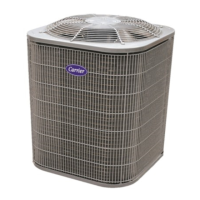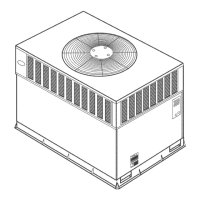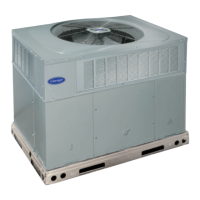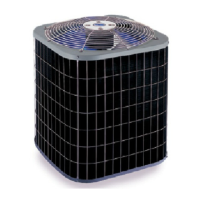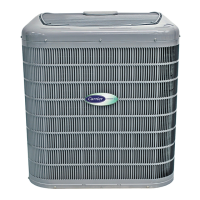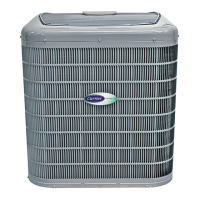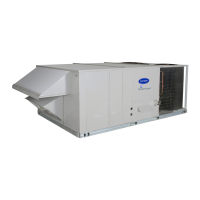38
STATUS CODE 46, BROWNOUT CONDITION:
If the secondary voltage of the transformer falls below 15VAC for
a period exceeding 4 seconds, Status Code 46 will be displayed on
STATUS LED. If system includes a non--communicating outdoor
air conditioner or heat pump, the User Interface will command the
blower to turn off Y output controlling compressor.
When secondary voltage rises above 17VAC for more than 4
seconds, the brownout condition is cleared and normal system
operation will resume subject to any minimum compressor off
delay function which may be in effect. Brownout does not affect
blower or electric heater operation.
STATUS CODE 5 3 , OUTDOOR AIR TEMPERATURE
SENSOR FAULT:
If an OAT sensor is found at power--up, input is constantly checked
to be within a valid temperature range. If sensor is found to be
open or shorted at any time after initial validation, Status Code 53
will be displayed at amber STATUS LED.
Check for faults in wiring connecting sensor to OAT terminals.
Using an Ohmmeter, check resistance of thermistor for a short or
open condition. If thermistor is shorted or open, replace it to return
the system to normal operation. If fault is in the wiring
connections, correcting the fault will clear the code and return the
system to normal operation.
NOTE: If fault condition is an open thermistor or a wiring
problem that appears to be an open thermistor and the power to the
ECM board is cycled off, the fault code will be cleared on the next
power--up but the fault will remain and system operation will not
be as expected. This is because on power--up, the ECM board
cannot discern the difference between an open sensor or if a sensor
is not installed.
ECM MOTOR TROUBLESHOOTING
The ECM motor used in this product consists of two parts: the
Control Module and the motor winding section. Do not assume
motor or module is defective if it will not start. Use the
designed--in LED information aids and follow troubleshooting
steps described below before replacing motor Control Module or
entire motor. Motor Control Module is available as a replacement
part.
VERIFY MOTOR WINDING SECTION:
ELECTRICAL SHOCK HAZARD
Failure to follow this warning could result in personal injury
or possible equipment damage.
After disconnecting power from the ECM motor, wait at least
5 minutes before removing the control section. Internal
capacitors require time to discharge.
!
WARNING
Before proceeding to replace a motor Control Module:
1. Check motor winding section to be sure it is functional.
2. Remove motor Control Module section and unplug winding
plug. Motor shaft should turn freely, resistance between any
two motor leads should be similar and resistance between
any motor lead and unpainted motor end should exceed
100,000 ohms.
3. Failing any of these tests, entire ECM motor must be re-
placed.
4. Passing all of the tests, motor Control Module alone can be
replaced.
MOTOR TURNS SLOWLY:
1. Low static pressure loading of blower while access panel is
removed will cause blower to run slowly. Particularly at low
airflow requests. This is normal, do not assume a fault ex-
ists.
2. Recheck airflow and system static pressure using user inter-
face service screens with access panel in place.
NOTE: Blower motor faults will not cause a lockout of blower
operation. ECM board will attempt to run the blower motor as long
as user interface maintains a demand for airflow . ECM board will
not operate electric heaters while a fault condition exists. The ECM
board communicates with the motor at least once every 5 seconds,
even when the motor is idle. If, during operation, the ECM board
does not communicate with the motor for more than 25 seconds,
the motor will shut itself down and wait for communications to be
reestablished.
S Using Motor LED in Troubleshooting
The MOTOR LED is connected to the blower motor
communication line and works with the ECM board
microprocessor and the STATUS LED to provide blower operation
and troubleshooting information. When the motor is commanded
to operate, the MOTOR LED will be turned on and will flash each
time instructions are sent to the motor. When the motor is
commanded to stop, the MOTOR LED will be turned off.
If the MOTOR LED is lit, flashing and the motor is running or if
the MOTOR LED is off and the motor is stopped, operation is
normal and no motor fault exists.
If the MOTOR LED is lit, flashing and the motor does not run, or
if the MOTOR LED is off and the motor is running, check the
STATUS LED for the Status Code. Refer to the troubleshooting
instructions for the indicated Status Code in Section E, blower
Troubleshooting.
